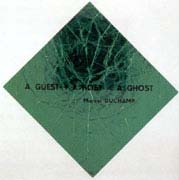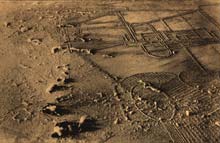|
Let's consider another important note from the Green Box.
This note contains a lot of suggestions, which so deeply resonate with my way of seeing things that it is very difficult for me to discern the projections of my imagination from what is really present in the note itself. However, due to the peculiar language used by Duchamp for the Green Box's notes, the analysis always gives free play to one's imagination (intentionally, I think, by Duchamp). Coming to the specific of the note, observe that the Bride's orders pass through the nets: in the Large Glass system the Bride is queen. One of her essential apparatuses is the so-called Wasp, and the idea of a wasp-queen makes me think to the social organization of the Hymenoptera (insects like bees, ants or just wasps). At the vertex of their complex systemic organization there is the queen. In addition to the important reproductive function, she regulates many vital functions of the community by emitting some chemicals (for instance, when a certain concentration of a particular hormone produced by the queen is reached, then a new swarming is induced). In fact, from the viewpoint of an observer, these chemical emissions can be described as orders. The Milky Way at the top of the Large Glass really has the appearance of an entomological representation (like a large caterpillar, or like the flaccid abdomen swollen with eggs of the queen). An undeniable entomological suggestion also emanates from the description of the Wasp apparatus, with its secretions, the filamentous material, the ventilation mechanism (just as in a hive). In brief, the first suggestion is for a representation of an insect society: at the top lies the queen, at the bottom there is the intricate industriousness of the subaltern castes. Now, we must underline
a little but meaningful detail. In the Large Glass the Wasp is
only one of the Bride's apparatuses, whereas I have spoken about it
in terms of just the Bride. This identification between part (the Bride's
apparatus) and whole (the same Bride) is authorized by Duchamp himself,
as we shall see better below, because it is the same relation, openly
declared by Duchamp, between the Bride (part) and the Large Glass
(whole): thus, the identification whole-part (Glass-Bride) is repeated
(once again) on a lower scale (Bride-Wasp). Furthermore the identification
Bride-Wasp is consistent with the Bride's psychic portrait made by Schwarz
(1974). Schwarz also recalls a nightmare which Duchamp had while
he was terminating the Bride in Munich: the Bride became an enormous
insect that atrociously tortured him (147).
The second suggestion refers to the punched cards of either the industrial machines or certain musical barrel organs which one could see along the streets of a city in those years. Punched cards means coded orders; hence, the queen issues her orders disposing particular combinations of the holes of the three nets--punched cards. The three nets are placed in loco for as long as two or three months, so that they can spontaneously and plastically assume a shape that conforms to the flow of the Bride's orders; thus, the code useful to transmit the Bride's orders will automatically organize itself--it will be based on the system of the mutual positions of the three nets. This code will then remain permanently impressed in the system by means of their trace. Thus, Duchamp provides for a prolonged exposition of the nets to stochastic events, which will model their own code. Biologically speaking, all of this evokes the idea of an adaptive process in progress. Exactly like the one that produced evolution of the effective biochemical system for the self-regulation of a hive. My last suggestion from the note, closely linked to the previous one, is mathematical, and refers to the behavior of the neural networks. Gurney states his definition :
In other words, the neural networks are mathematical formalisms, which simulate the interconnections and the activity of the neurons. They are formed by numerical variables, interconnected in a network-like structure and recursively recalculated, in such a manner as to optimize the performances of the network itself, on the basis of the target for which it is designed, proceeding by trial and error. Hence, the neural networks model themselves by a process sometime very similar to the evolutionary one, on the basis of the target, which is pursued as a goal from time to time. Thus, the neural network exhibits the same kind of organization as the evolutionary process. This is the way the networks learn: it is a process of internal and recursive self-organization. Undoubtedly, all this is very similar to the behavior imagined by Duchamp for his Milky Way nets. It is now necessary to underline that in the years when Duchamp wrote the Green Box notes neither biochemistry (especially when applied to the study of hive behavior) nor the neural networks (especially the so called multi-layer network as is the case with Duchamp's networks) existed. Thus, I don't want to hypothesize either that Duchamp was influenced by the knowledge of similar concepts, or that he wished to create with the Large Glass a metaphor of a complex system (like an insect society or a neural network). Finally, I don't want to state that Duchamp's intuitions forerun in any way some future specific scientific result. Simply, I think that concepts like recursion, self-reference, circular feedback (and so on) are so deeply linked to each other and to the concept of self-organization that the latter aspect must somehow find an expression, even if implicitly, as in the present case.
Further clarification is also necessary. Even in the elaboration of the Seives of the Large Glass, Duchamp planned another stochastic system (and really executed it), exposing the Glass to the dust throughout about four months. The famous photo of the detail of the Large Glass covered by dust, executed in 1920 by Man Ray, titled Dust Breeding (Fig. 32), documents the result. However, this example (although important) doesn't concern the above suggested aspect of self-organization. Here we have a pure randomness that blindly produces a result, surely interesting, but without a specific organization; there we had the same randomness, which instead produced organization (the creation of the code). In other words, and speaking in terms of entropy: here we have an increasing entropy, where previously we had a reduction. >>Next
page 1 2 3 4 5 6 7 8 9 10 11 12 13 14 15 |














